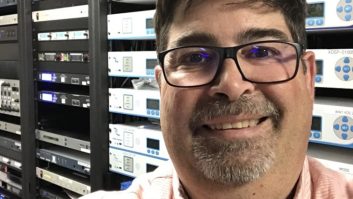MPLS Networks
Dec 1, 2011 1:30 AM, By Kevin McNamara
You may not be familiar with the term Multiprotocol Label Switching (MPLS); however, it is a technology that that will find a way into your facility in the not-too-distant future, if not already utilized. What exactly is MPLS? At the highest level, MPLS is a highly scalable alternative method to route different types of data through a common network. In a broadcast environment MPLS would permit the mixture of protocols, including those used for video, audio and traditional IP traffic, over the same network. MPLS is typically deployed within a wide area network (WAN) and can be provisioned using copper, fiber or wireless microwave radio transport media.
History
The roots of MPLS go back to 1996 when a group from Ipsilon Networks proposed a technology called IP Switching, which at the time, was designed to only work on ATM networks. Cisco was the first to call it Label Switching, which was introduced as a similar proprietary protocol. In 1997 the first MPLS working group was formed and the first deployment of an MPLS network was completed in 1999.
MPLS has been closely compared to an ATM (Asynchronous Transfer Mode) network, and while it shares some of the same characteristics – i.e. connection oriented transport services – they are very different. Perhaps most notable is that ATM can only handle fixed-sized packets, while MPLS can work with a multitude of protocols and data packet sizes. MPLS networks tend to be more secure as they can broadcast specific packets of data to specific destinations as opposed to an IP network broadcast, which provides little security over who might be able to receive data.
About label switching
Conventional IP routing typically works in Layer 3 of the OSI model, otherwise called the Network layer. You may recall that this is the portion of the OSI stack responsible for forwarding data packets, including the addressing, forwarding and routing functions. IP routing also requires a great deal of management to track the source and destination addresses in order for the data packets to be routed to the proper destinations in the most efficient manner. While IP routing can be very efficient there is still a high degree of latency (relatively speaking) due to this management overhead.
Unlike IP routing, MPLS utilizes so-called labels to send data frames to other MPLS networks. Not unlike the typical information that encapsulates data packets in an IP network, labels contain certain information about the data; however, they are not made part of the original IP packet, rather they are inserted between Layers 2 (Data Link) and Layer 3, in essence tagging the MPLS stack to the beginning of the IP packet. I use the term stack because the label is essentially a virtual layer within the OSI stack between Layer 2 and 3. Some people refer to MPLS as Layer 2.5. It is also possible to stack more than a single label, which is used in certain routing applications.
The label consists of the following information:
? The label: 20 bits (which can yield approximately 1 million different labels)
? Class of service: 3 bits. This provides the ability to prioritize up to 7 different levels of traffic.
? Stack bit: 1 bit. This defines whether or not this is the last MPLS Label in the frame. Remember I mentioned that there can be multiple labels in a frame.
? Time-to-live: Defines how many different MPLS routers can be traversed before the packet dies.
– continued on page 2
MPLS Networks
Dec 1, 2011 1:30 AM, By Kevin McNamara
Network architecture
In terms of hardware requirements MPLS utilizes three main components:
? Ingress Label Edge Router (LER): Provides insertion of the Labels
? Egress Label Edge Router (LER): Strips the labels and forwards the IP data as necessary
? Label Switch Router (LSR): Essentially manages the labeled packets, including swapping old labels with new labels (as it passes the label to the next router) and a host of other management functions.
In terms of hardware requirements MPLS utilizes three main components:
? Ingress Label Edge Router (LER): Provides insertion of the Labels
? Egress Label Edge Router (LER): Strips the labels and forwards the IP data as necessary
? Label Switch Router (LSR): Essentially manages the labeled packets, including swapping old labels with new labels (as it passes the label to the next router) and a host of other management functions.
Label Switched Path (LSP). This is a unidirectional tunnel created between any two LER devices. LSP must be used in order to forward any MPLS data.

Figure 1. An MPLS cloud has data enter through an Ingress Edge Router (LER), travel through the Label Switch Router (LSR) and then back to an Egress Edge Router to its next destination.
Perhaps an MPLS network can be best viewed as a cloud. Data enters the cloud through the Ingress Edge Router, travels through the Label Switch Router and then back out to the Egress Edge Router onto to its next destination. Figure 1 provides an example.
Deploying MPLS in broadcast
There are several characteristics that set MPLS apart from an IP-based network, particularly as a means to connect groups of radio stations, both regionally and nationally. Here are a few reasons to look at it:
? MPLS supports bi-directional data paths.
? Properly designed MPLS networks are very scalable and fault tolerant.
? Easy to configure.
? Supports any protocol, thus allowing the ability to carry several different infrastructure requirements over a single network i.e. voice and data traffic. Operational and capital expenses are significantly reduced.
? Priority levels can be assigned to specific types of data.
? Network latency is less than traditional IP routing.
? No need to utilize channel banks i.e. DS1,2,3,etc. Bandwidth is allocated based on need and priority.MPLS networks are well suited to handle the demands of the largest broadcast groups as well as smaller local operations.
McNamara is president of Applied Wireless, Cape Coral, FL.
December 2011
Backstage at A Prairie Home Companion, a look at Ethernet-based audio routing systems, details of MPLS networks, and Field Reports on the Orban Optimod-FM 8600 and Harris PR&E Netwave….







